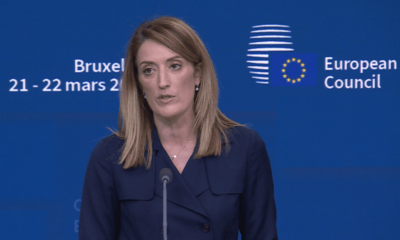Travel
Finland, Montenegro, Albania: Which digital nomad visa in Europe has the lowest income requirement?
Spain has just increased its income requirements, but its digital nomad visa still isn’t one of the highest in Europe.
Foreigners in Spain who have a digital nomad visa or are thinking of applying for one this year will be subject to higher income requirements in 2025.
The monthly earning threshold is linked to Spain’s minimum wage – and the government has reached an agreement with the country’s main trade unions to increase this by 4.4 per cent this year.
This raise equates to €50 more per month, taking it up to €1,184 per month across 14 payments (€16,576 gross per year).
To understand how this translates for the digital nomad visa financial requirements, it has to be calculated as 12 payments of €1,381.33 per month.
Digital nomad visa applicants need to demonstrate that their monthly earnings are equal to 200 per cent of the minimum wage.
This means you now need to earn at least €2,762 per month to be eligible for the visa in 2025 – up more than €100 a month from last year.
Despite the increase in income requirements, Spain’s digital nomad visa still isn’t one of the highest in Europe.
Here’s how other European countries compare.
Iceland’s digital nomad visa has the highest income requirements
Iceland’s remote work long-term visa is aimed at high-income individuals earning €7,075 per month, the highest in Europe.
Workers can apply either as employees of a foreign company or as freelancers. The visa lasts for six months, and applicants are considered tax residents during this time.
Estonia comes in second, with applicants of the digital nomad visa requiring a gross monthly income of €4,500 a month. The visa lets people working remotely for companies abroad – or freelancers with clients mostly abroad – stay in Estonia for up to one year at a time.
If you remain in the country for more than six months, you will gain tax residency and be subject to local taxes.
Romania’s digital nomad visa, aimed at non-EU citizens, sets its income requirement at €3,950 per month, which is three times the country’s average gross salary.
In 2023, Romanian president Klaus Iohannis signed a new bill to clarify tax requirements for digital nomads. Those staying for long periods are exempt from paying income tax, social security, and social health insurance contributions.
Finland’s digital nomad visa has the lowest income requirements in Europe
Despite having high living costs, Finland requires digital nomad visa applicants to earn a minimum of just €1,220 per month.
Finland’s self-employment visa is open to non-EU entrepreneurs who are self-employed or run an independent business.
Montenegro’s requirements are also low, at around €1,400 per month. Participants can use the scheme to live in the country for up to four years. Digital nomads are eligible for tax breaks, although details are still to be confirmed.
Digital nomads can apply for an Albanian residence permit that allows them to stay and work in the country for up to one year. Introduced at the start of 2022, the so-called ‘Unique Permit’ can be renewed up to five times in a row.
Remote workers must show proof of an employment contract for a company outside of the country that allows them to work remotely, as well as proof of funds to support themselves of an estimated €9,800 a year.
Travel
Dubai is the world’s busiest airport, but is the tourism boom begining to strain the affluent city?
Dubai is welcoming more tourists than ever, but local residents don’t always benefit.
Dubai International Airport was the world’s busiest for international travel in 2024, officials announced on Thursday.
The hub saw a record 92.3 million passengers pass through its terminals last year.
The result cements Dubai’s bounce back from the coronavirus pandemic, surpassing the previous record set in 2018 for the first time.
It coincides with a real-estate boom and the city’s highest-ever tourism numbers, which have made Dubai a trending destination as well as a popular layover stop.
However, the city is now grappling with increasing traffic and housing costs, pressuring both its Emirati citizens and the foreign residents who power its economy.
Dubai Aiport was the world’s busiest in 2024
Today, Dubai International Airport feels like it is bursting at the seams with aircraft movements and crowds passing through its cavernous terminals.
Dubai’s ruler, Sheikh Mohammed bin Rashid Al Maktoum, announced the record number of passengers on the social media platform X.
The state-owned airport is home to the long-haul carrier Emirates, which powers the network of state-owned and state-linked businesses known as ‘Dubai Inc’.
“Dubai is the airport of the world […] and a new world in the aviation sector,” Sheikh Mohammed wrote.
In 2023, the airport, known as DXB, had 86.9 million passengers. Its 2019 traffic was 86.3 million passengers. It had 89.1 million passengers in 2018 – its previous busiest-ever year before the pandemic – while 66 million passengers passed through in 2022.
Dubai plans move to city’s second airport
In 10 years, authorities plan to move operations to the city-state’s second airport after a nearly $35 billion (€33.5 billion) upgrade.
Al Maktoum International Airport is roughly 45 kilometres away from DXB.
The airport, which opened in 2010 with one terminal and is known as DWC, served as a parking lot for Emirates’ double-decker Airbus A380s and other aircraft during the pandemic.
But since then, it has slowly returned to life with cargo and private flights. It also hosts the biennial Dubai Air Show and has a vast, empty desert in which to expand.
DXB and DWC serve 106 airlines flying to 272 cities in 107 countries across the world.
Dubai grapples with tourism boom
While tourism adverts continue to entice travellers to the city, the constant increase in arrivals is putting a strain on the local population and infrastructure.
Traffic on Dubai’s roads is becoming a nightmare for commuters. The price of housing continues to spike, even with new real estate projects being announced almost daily.
“Dubai is on steroids but affordability risks are increasing,” Hasnain Malik warned in a report for the global data firm Tellimer, where he’s a managing director.
Travel
Ryanair CEO lashes out at Spanish minister after blackmail accusations over seat cuts in 2025
Travellers will find fewer low-cost options at Spanish regional airports this summer.
European low-cost behemoth and one of the biggest budget airlines in the world, Ryanair has pulled thousands of seats from its schedules for 2025 across several Spanish airports.
In all, seven airports will have their Ryanair services reduced, some by as little as five per cent. Others will see the exit of the budget airline entirely.
Overall, Ryanair is removing a total of 800,000 seats from the Spanish market, representing 18 per cent of its overall operations in the country. Twelve routes will be lost altogether.
The airline says this is because of the fees imposed by Spanish airport operator Aena, which it deems ‘excessive.’ However, Aena has hit back at the airline, accusing it of ‘blackmail’ and suggesting that Ryanair is using its weight to try and get airport access for free.
“Unfortunately, this is Ryanair’s modus operandi,” says Maurici Lucena, President of Aena. “In many European countries, we have seen it for years: threats, half-truths, lies…; but in the case of Spain, I honestly believe that today they have crossed the Rubicon of respect, good faith and the most basic business and institutional courtesy.”
On Wednesday, the spat escalated after Ryanair CEO Michael O’Leary brought up another contentious incident.
In November 2024, the Spanish government fined five airlines for ‘abusive practices’ including charging passengers for carry-on luggage. Ryanair was hit with the biggest penalty of €107.8 million.
During a news conference in Brussels, O’Leary lambasted Spanish consumer rights minister Pablo Bustinduy, calling him “a crazy communist minister” who penalised airlines that “have no choice but to restrict carry-on bags”.
Bustinduy hit back saying that “no pressure, no blackmail and no insult will stop me” in his duty to defend the country’s consumers above multinationals and magnates, “however powerful they may be”, news site The Local reports.
Which airports are losing Ryanair service?
It is mainly regional airports in Spain that are losing either part or all of their Ryanair services.
Most affected are Jerez and Valladolid, which the budget airline will pull out of entirely.
According to Aena, Valladolid will be left with only one commercial operator once Ryanair exits – Binter Canarias, with its twice-weekly service to Gran Canaria.
Jerez will fare better, with existing services from Binter, Air Nostrum and Vueling connecting it to Madrid, Barcelona, Mallorca, Tenerife and Gran Canaria.
Of the other airports, Vigo will lose the most capacity, with Ryanair cutting 61 per cent of its flights.
At Santiago, Ryanair will remove one aircraft from its base there, leading to a 28 per cent reduction in capacity. Zaragoza, Asturias and Santander will also lose a few Ryanair flights.
“Aena’s excessive airport charges and lack of workable growth incentives continue to undermine Spain’s regional airports,” says Eddie Wilson, CEO of Ryanair. “As a result, Ryanair will cease its entire Jerez and Valladolid operations, remove 1 based aircraft from Santiago ($100m investment) and reduce traffic in Vigo, Santiago, Zaragoza, Asturias, and Santander (loss of 800,000 seats) in Summer 2025.”
What are the fees Ryanair is unhappy with?
Aena says that the average charge being paid by airlines for airport services as of 1 March will remain frozen at €10.35 per passenger, the same as it was in 2024.
“Aena’s refusal to incentivise airlines to use underutilised capacity at its regional airports has forced Ryanair to reallocate aircraft and capacity to more competitive European markets,” Wilson adds.
However, Aena disputes the assertion that they are not incentivising airlines to make use of regional airports. At the end of October 2024, the airport management company approved an initiative to stimulate growth by subsidising its 17 regional airports.
Specifically, for those airports with fewer than three million passengers and which had not returned to their pre-pandemic passenger levels, Aena has offered a 100 per cent discount for additional passengers over and above the 2023 levels.
Aena says that, in reality, this incentive scheme would reduce Ryanair’s per-passenger fee to just €2.
“Aena cordially urges Ryanair to calm down and abandon its long-standing and regrettably well-known mendacious, aggressive and threatening business and communication strategy,” the airport operator says, “which it is very difficult not to interpret as an attempt to blackmail Aena, the region and, ultimately, the Spanish public.”
Are the fees at Spanish airports hampering growth?
Aena says its fees are amongst the lowest in Europe, although Ryanair says this isn’t true.
Inflationary pressures have seen everything become more expensive, including in aviation. From fuel and staff to supplies and services, it all costs more than it used to and airlines have been quick to pass on to passengers.
The International Air Transport Association (IATA) says that airfares increased 16 per cent in 2024 compared with 2019. However, Airports Council International (ACI) has published research that suggests they’re more like 38 per cent higher.
On the other hand, airports have not been able to raise their charges to the same magnitude. ACI says that airport charges in Europe rose just 13.6 per cent in 2024, far below the cost increases airports are experiencing.
“Many airports have yet to fully reflect inflationary pressures in their user charges,” says Olivier Jankovec, director general of ACI Europe. “Regulators are often oblivious of these pressures and of how debt accumulated through COVID is hurting their investment capabilities.”
Part of Ryanair’s argument is that Aena was allowed to raise fees by 4.09 per cent in 2024, despite the Spanish government ruling in 2021 that airport fees would be frozen for five years.
In 2023, the Comisión Nacional de los Mercados y la Competencia (CNMC) approved the rise, which shakes out to a total of €0.40 more per passenger. Aena again proposed an increase for 2025, which would have added €0.05 to the cost for airlines, but it was refused by CNMC.
Despite Ryanair’s assertions that fees are at the heart of its schedule changes, the argument weakens when its entire Spanish operation is considered.
“I am surprised that they are questioning the profitability of these routes,” says Lucena. He goes on to explain that Ryanair’s flights from the regional airports have been full – fuller even than those at major city airports.
Throughout 2024, Ryanair increased its activity at Spanish airports by 8.7 per cent. For 2025, despite the cuts the airline has planned, its Spanish activities will increase again, with around 5 per cent more flights overall.
Ryanair is continuing to grow at the largest and most touristic Spanish airports. These airports do not attract the incentive discount, and airlines are charged the full €10.35 per passenger.
“In reality, what Ryanair has announced is that it will withdraw a very small percentage, in relative terms, of its total operations,” says Lucena. “The 800,000 seats they announced account for exactly 1.21 per cent of all passenger traffic they carried in 2024.”
He adds that Ryanair is masking business-led route cuts to exert pressure on Aena and the government.
Lucena even goes so far as to say that, under Spanish law, Ryanair’s moves could even be considered illegal. “In short, it’s all rather unpleasant and regrettable,” he concludes.
In a statement, Aena reiterated its position, saying, “Despite its grandiloquent rhetoric, Ryanair’s constant public pressure boils down to a simple goal: to use a significant portion of Spanish airports for free, which would jeopardise the long-term financial sustainability of Spain’s airport system.”
Travel
D.C. flight is the latest fatal plane crash: Is flying still the safest form of transport?
As the American Airlines crash adds to a recent spate of air accidents, we look at the safety of flying and find cause for hope.
An American Airlines plane with 64 passengers and crew collided mid-air with a military helicopter yesterday (29 January) as it approached Ronald Reagan National Airport near Washington, just five kilometres south of the White House and the US Capitol.
Plummeting into the Potomac River, reports are emerging that there are multiple fatalities, although numbers are still unconfirmed.
This is one of several airline crashes in recent months, but according to experts, flying is still the safest form of transport.
How did the American Airlines plane crash – and what was the response?
Traffic controllers had requested American Airlines Flight 5342 to land on a shorter runway just minutes before the aircraft was due to land, to which the pilots agreed, adjusting their approach.
Minutes later, the plane collided with a UH-60 Blackhawk helicopter, which was carrying a crew of three soldiers, an Army official confirmed.
Authorities are now conducting a massive search-and-rescue operation. Inflatable boats launched into the river while first responders erected light towers from the shore to illuminate the area.
No official death count has been announced, yet US senator Roger Marshall of Kansas has hinted that it will be high. “When one person dies it’s a tragedy, but when many, many, many people die it’s an unbearable sorrow,” he said.
Fatal crashes of American commercial airlines are rare
Investigators are already trying to piece together the aircraft’s final moments by speaking with air traffic controllers and assessing why the passenger jet lost altitude prior to crashing.
In 1982, an Air Florida flight similarly crashed into the Potomac River, killing 78 people, which was attributed to bad weather.
The last fatal crash of a passenger plane in the United States took place in 2008, when 49 passengers are crew were killed near Buffalo, New York, when a Bombardier DHC-8 propeller plane crashed into a house.
The deadliest plane crash in US history continues to be on September 11, 2001, when four jetliners were hijacked by al-Qaida, sending two planes into the World Trade Center in New York, one into the Pentagon in Virginia, and a fourth into a field in western Pennsylvania. Nearly 3,000 people were killed and this incident remains the deadliest terror attack in history.
2024 was a deadly year for air travel
This latest plane crash in Washington has fanned the flames of recent concerns over flying: at the end of 2024, more than 200 people lost their lives in two separate incidents just days apart.
Thirty-eight people died in December when an Azerbaijan Airlines plane crashed in Kazakhstan; four days later, 179 perished when a Jeju Air flight crash landed in South Korea.
While recent events are still ringing in the minds of many, there were other disasters in aviation in 2024. In early January, a fiery crash in Tokyo shocked the world, leaving five members of the Japan Coast Guard dead, although passengers on the Japan Airlines plane escaped safely.
Days later, part of a plane fell off when it was departing from Portland, Oregon, leaving a gaping hole in the side of the fuselage. Again, all 177 passengers survived the emergency landing, but the fallout from the event has seen major manufacturer Boeing in the spotlight all year.
During the summer the tragic loss of a Voepass flight in Brazil claimed the lives of 62 passengers and crew.
On top of this, multiple reports of aircraft hitting severe turbulence and injuring people, including one fatality on a Singapore Airlines flight, have given travellers cause to worry about their safety.
According to the Aviation Safety Network, a total of 318 people died in aircraft accidents last year, making 2024 the deadliest year in aviation since 2018.
But is flying really becoming less safe, and should we be worried if we’ve got an upcoming trip booked?
Flying is getting safer all the time
Dr Hassan Shahidi, president and CEO of Flight Safety Foundation, a non-profit involved in all aspects of aviation safety, put things in perspective for Euronews Travel.
“In all of 2023, there were zero commercial jet fatalities,” he says. “By the time 2024 was over, the aviation industry had transported 5 billion passengers worldwide. And until just the past few days, 2024 was poised to repeat that safety record.”
According to research from the Massachusetts Institute of Technology (MIT), flying is safer today than ever.
In the 2018-2022 period, the risk of dying through air travel was calculated to be 1 per every 13.7 million passenger boardings. That’s down from 1 per 7.9 million boardings in 2008-2017 and a major decrease from the 1 per every 350,000 boardings in 1968 to 1977.
Research from Embry-Riddle Aeronautical Academy has shown that up to 80 per cent of aviation accidents can be attributed to human error. A mistake on the pilots’ part is thought to account for 53 per cent of accidents, while mechanical failure was considered to be at fault in just 21 per cent of cases.
Airbus studied which part of the flight was most dangerous, and found that takeoff and landing were when accidents were most likely to occur. Both of the two December 2024 crashes happened when landing, although other factors were in play.
In the Jeju Air crash, for example, there were reports of an engine being damaged after hitting a bird, and the aircraft, for an as yet unknown reason, did not have its landing gear deployed when it touched down. The investigation will be long and complex, and it’s likely to be some time before we understand exactly what happened.
“This accident involved a multitude of factors, from bird strikes to landing without landing gear and flaps,” Shahidi adds. “All of this will be thoroughly investigated, contributing factors will be determined and steps will be taken to ensure this doesn’t happen again.”
Jeju Air has been inspecting its fleet of 737 ‘next generation’ (NG) aircraft, but out of an abundance of caution. Nothing so far suggests that there is a more widespread problem with the aircraft type.
Airlines are advised to avoid warzones
The Azerbaijan Airlines crash was something a little different. Although investigations are ongoing, initial assessments suggest the aircraft may have been hit by Russian air defences, causing it to depressurise and lose control.
That assessment will bring to mind a similar situation from a decade ago. In July 2014, a Malaysia Airlines plane was shot down by Russian-backed forces using a surface-to-air missile while it was flying over eastern Ukraine. All 283 passengers and 16 crew members died.
The investigation recommended states involved in armed conflicts close their airspace, and that operators should thoroughly assess risk when routes pass over areas of conflict.
The European Aviation Safety Agency (EASA) publishes Conflict Zone Information Bulletins to caution air operators about potential safety threats.
However, as Janet Northcote, spokesperson for EASA, explains to Euronews Travel, “EASA does not close airspace or have the right to mandate the avoidance of airspace. But the information provided here flows into the individual airline’s own safety assessments and creates awareness of any aviation safety threat.”
So why was Azerbaijan Airlines flying over a conflict zone? Although many Western airlines have ceased operations to and over Russian airspace, numerous Middle Eastern and Asian airlines continue to operate in that area.
Carriers from Turkey, China, the UAE and other nations are not avoiding the airspace, despite the risk.
“Air travel in known conflict zones has significant risk,” Shaihid says. “Airlines must carry out risk assessment for their routes to ensure that the risks are mitigated and take an alternate route.”
Nonetheless, no European airline currently flies to Russia or through its airspace, having heeded the advice of EASA and other agencies.
Every air accident makes air travel safer
The small silver lining in the terrible year aviation has experienced is that every accident serves to make air travel safer in the future.
As Simon Calder, travel correspondent for the UK’s Independent newspaper wrote in a recent column, “All the dramatic aviation events of 2024 – fatal and otherwise – will be analysed minutely to understand what can be learnt to enhance future safety.”
In the case of both the Jeju Air and Azerbaijan Airlines crashes, the infamous ‘black boxes’ have been recovered and sent for interrogation.
These two boxes, which are actually bright orange in colour, are the Flight Data Recorder (FDR) and Cockpit Voice Recorder (CVR) and should shed some light on what happened prior to the crash.
Accident investigators are on the ground in Kazakhstan and South Korea gathering more evidence, a process that could take some time. Following this, collected data will be analysed in a lab to determine the cause of the crash.
A preliminary report will likely be made public in the coming weeks, although the final report will take longer.
From these reports, various recommendations will be made to avoid a similar situation in the future.
“One of the strengths of aviation safety processes is that whenever any tragedy does occur, we analyse what happened and take appropriate action to ensure, to the extent possible, that the same type of accident will not occur again,” explains Northcote.
Consider any major aviation accident, and it’s possible to see the longer-term positive effect it has had on air safety.
A collision over the Grand Canyon in June 1956, for example, between a TWA Super Constellation and a United Airlines DC-7 led to upgraded forms of air traffic control.
After TWA Flight 800 exploded in mid-air in 1996, modifications were made to ensure fuel could not be combusted by an errant spark.
Without the tragedy of 9/11, the Transportation Security Administration (TSA) would never have been created. And thanks to the (still) missing Malaysia Airlines MH370, all aircraft are now tracked in real-time.
“This constant cycle of improvement is fundamental to keeping the aviation safety record strong,” says Northcote.
“We work with other regulators, for example the Federal Aviation Administration (FAA) in the United States and with the International Civil Aviation Organisation (ICAO), to ensure that aviation safety standards are high globally, not only in Europe.”
While manufacturers, airlines and regulators work hard to maintain safety in the skies, Northcote highlights that safe travel is a team effort.
“Aviation has in general an excellent safety record, but this is no cause for complacency,” she says. “This strong safety record can only be maintained by many individual people fulfilling their role every day to ensure that operations are safe.”
-

 Politics5 days ago
Politics5 days agoDemocratic Republic of the Congo: Statement by the High Representative on behalf of the EU on the latest escalation in eastern DRC
-

 Sports4 days ago
Sports4 days agoSerie A 2024-2025: Genoa-Monza, the likely lineups
-

 Politics5 days ago
Politics5 days agoYemen: Statement by the Spokesperson on the latest Houthi arbitrary detentions of UN personnel in Yemen
-

 Politics5 days ago
Politics5 days agoRoberta Metsola – European Leadership And Political Representation
-

 Sports6 days ago
Sports6 days agoFabio Pecchia trusts Parma’s newcomers and warns AC Milan
-

 Sports4 days ago
Sports4 days agoSerie C, round C, 2024-2025: Crotone-Picerno, the probable formations
-

 Sports4 days ago
Sports4 days agoSerie C, round C, 2024-2025: Altamura-Taranto, the probable formations
-

 EU & the World5 days ago
EU & the World5 days agoWho Is Playing in Super Bowl 2025? The Teams Facing Off








